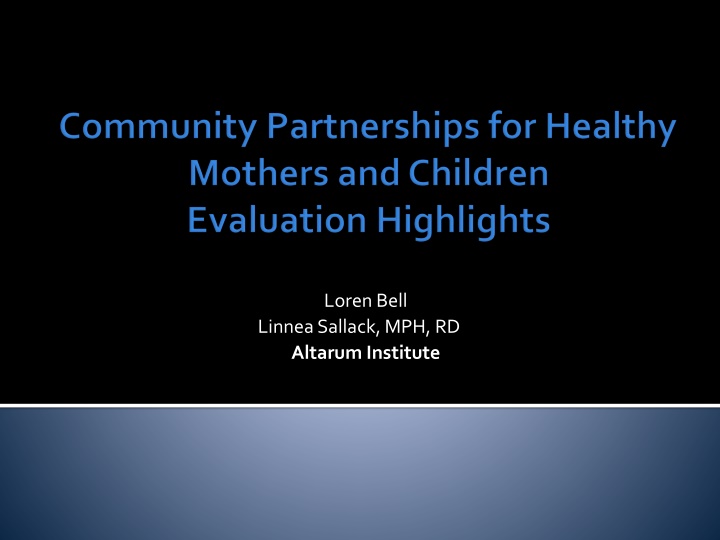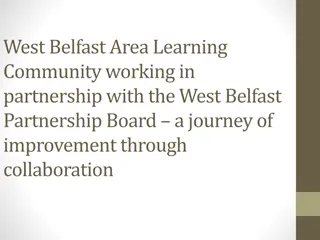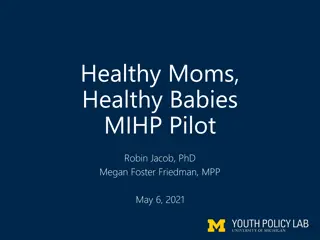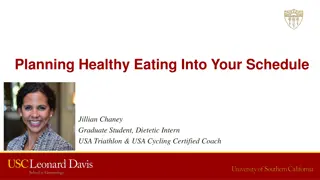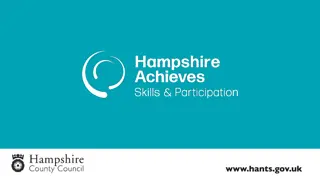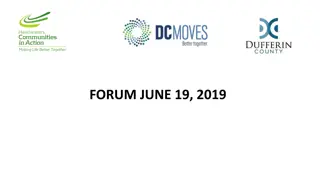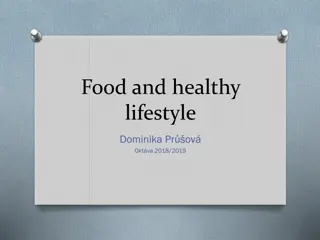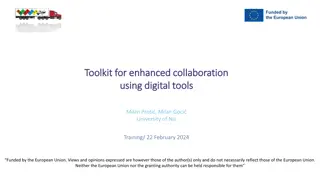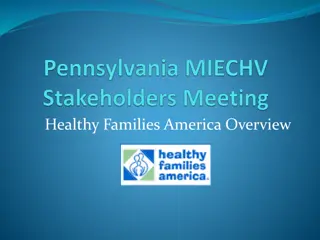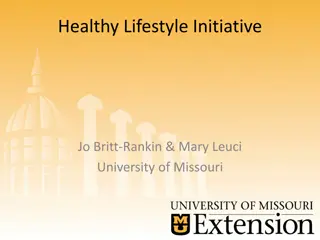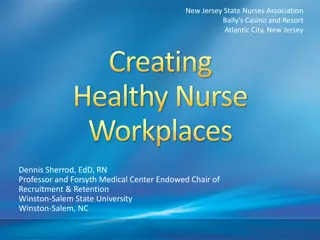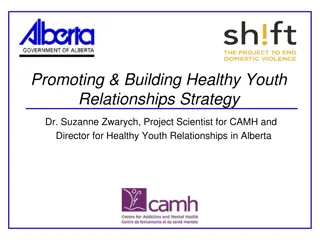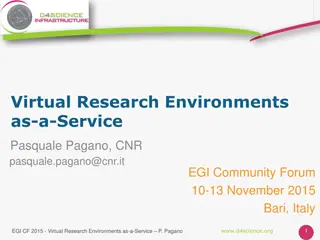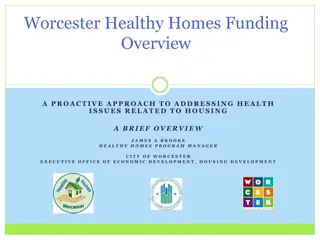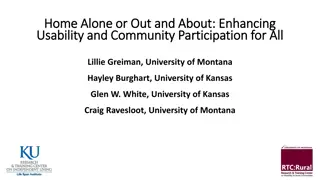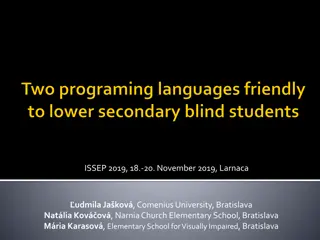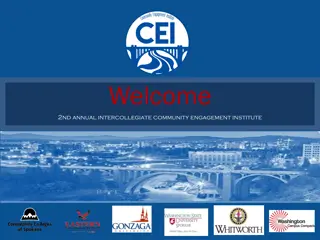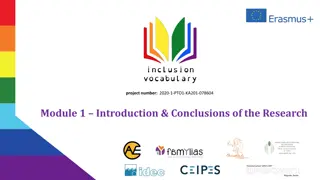Enhancing Community Collaboration for Healthy Environments
Increased collaboration between national and community partners, improved community capacity for implementing policy systems, and environmental improvements aim to enhance access to healthy food options and chronic disease prevention. Challenges in building coalitions early in projects were reported, but once established, barriers to implementing objectives were minimal, with most coalitions expected to continue beyond the project.
Download Presentation

Please find below an Image/Link to download the presentation.
The content on the website is provided AS IS for your information and personal use only. It may not be sold, licensed, or shared on other websites without obtaining consent from the author.If you encounter any issues during the download, it is possible that the publisher has removed the file from their server.
You are allowed to download the files provided on this website for personal or commercial use, subject to the condition that they are used lawfully. All files are the property of their respective owners.
The content on the website is provided AS IS for your information and personal use only. It may not be sold, licensed, or shared on other websites without obtaining consent from the author.
E N D
Presentation Transcript
Loren Bell Linnea Sallack, MPH, RD Altarum Institute
Increased collaboration between national and community partners Increased community capacity to implement policy systems, and environmental (PSE) improvements Increased messages on the importance of policy, systems, and environmental improvements Increased access to environments with healthy food or beverage options in local communities Increased opportunities for chronic disease prevention and care through community and clinical linkages in local communities
Capacity: Whether and how local projects achieved increased collaboration across partners and increased community capacity to implement PSE change. Project outcomes: Whether and how local projects achieved objectives to increase access to environments with healthy food or beverage options and increase opportunities for chronic disease prevention and care. Success factors: Describe what contributes---or presents challenges---to achieving objectives and sustaining project efforts.
Most Cohort 1 project coordinators reported little or some prior experience with community engagement--working collaboratively with and through groups to address issues affecting well-being. I m our agency s community outreach coordinator. I attend community partner meetings and health fairs. I established a breastfeeding coalition and have collaborated with food pantries.
About half the project coordinators reported challenges building coalitions early in the project due to: Lack of existing, viable coalitions Availability and time challenges for coalition members Time required to build relationships Delay in project launch
Once the coalitions were in place, most projects reported few barriers to implementing their objectives .and indicated most of the coalitions would continue beyond the project. The biggest success is the relationship building, bringing people from the community together to talk about what our needs are and how we can move forward as a group. I am surprised at the overwhelming support and involvement of our local government, stakeholders and community. Our coalition members are highly engaged and committed.
All projects indicated that they will continue to engage with some or all of the community partners after the project ended. Everyone is excited about the changes in our community and we will continue the strategies. It s a bigger picture for the way we re serving clients not just the WIC clients but the families, the community we are more of a team.
Cohort 1 & 2: Early-Implementation Experience with Community Engagement Early Implementation Survey 100% Percentage of Project Coordinators 90% 80% 40% 41% 70% None 60% Little 13% 50% Some 40% Substantial 47% 30% 33% 20% 10% 13% 12% 0% Cohort 1 (n=17) Cohort 2 (n=15)
Most Cohort 1 project coordinators reported limited prior experience with policy, systems and environment (PSE) change efforts. My focus is on programs providing services and resources vs. PSE work. Working with some community groups enabled us to work on policy-level changes such as community/worksite breastfeeding policies.
Lessons learned The PSE change thing was huge .going from individualized care to community engagement and policy change has been a big learning experience . The experience helped us in expanding our traditional roles because we have skills and experience to offer to the community. We were working on projects that impacted policy, system and environmental changes, but we didn t call it that or recognize it as being that! We were just improving our community .
Cohort 1 & 2: Early-Implementation Experience with PSE Efforts Early Implementation Survey 100% 18% 90% Percentage of Project Coordinators 33% 80% 70% None Little Some Substantial 35% 60% 13% 50% 13% 40% 30% 47% 20% 40% 10% 0% Cohort 1 (n=17) Cohort 2 (n=15)
Across all Cohort 1 projects Nearly 40% of the targets for intervention settings were achieved or exceeded. About half (48%) of the targets for population reached were met or exceeded. For targets not achieved, there was significant progress towards meeting the goals.
Most success reported for objectives around: Increasing healthy food options in stores Promoting WIC and enhanced WIC referral systems Developing tools and resources to increase awareness of healthy eating options and preventive care services Increasing businesses that publicly promote/welcome breastfeeding Increasing healthy restaurant menu options Greater access to and utilization of farmers markets Increasing donations of fresh produce by farmers to food banks/pantries
Greatest challenges reported for objectives around: Working with schools to increase offerings of drinking water and healthier food options Increasing the number of WIC-authorized retailers Implementing green prescriptions for healthy foods and lifestyles Increasing the number of businesses that that develop policies to support breastfeeding What will Cohort 2 experience?
All projects reported they would continue to work with the community partners. Most projects reported that coalitions would continue to meet. 75% of projects reported they would seek funds from other sources to continue their activities. Most projects reported activities would continue even if there was no additional funding. We are just getting started and the community is fully engaged and excited. We want to continue to grow.
Ensure community buy-in and facilitate effective community coalitions and partnerships. Foster ongoing communication and exchange of ideas among stakeholders. Leverage expertise of coalition members, partners and WIC staff. Be realistic and focused on the quality and feasibility not quantity of project objectives.
Plan thoughtfully and recognize that time and resources are limited. Learn/understand the cultural issues and needs of the community. Recognize--and borrow--successful efforts of other groups.
WIC can play an important role in creating partnerships to implement PSE changes for improving the food environment and promoting linkages for chronic disease prevention and treatment services. Building strong community coalitions leads to successful implementation of interventions and sustainability of these efforts. Some objectives and strategies require longer term commitments the short CPHMC period limited success. CPHMC projects are an asset for WIC agencies that are interested in community-based work there are many valuable lessons.
CPHMC project experience demonstrates WICs capacity to improve the community that exists outside of the clinic walls .to help families adopt healthy behaviors, have positive pregnancy outcomes and healthy children.
